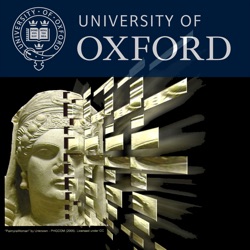Episoder
-
Part of the Conflict and Cultural Heritage Conference. Theme 3: What is being done or should be done? Exploring archaeological and military heritage protection initiatives. With Dr Emma Cunliffe (Heritage for Peace). Heritage for Peace is an international NGO entirely founded and run by volunteers, who work to protect heritage during conflict and assist their colleagues in Syria. This presentation will showcase their ideas and principles, some of their work, and some of the difficulties faced in working during a conflict. The second half will present a particular project: a regular report of international actions undertaken by the international community, demonstrating how the wider community has reacted, and how the approach of a small NGO can be successful.
-
Part of the Conflict and Cultural Heritage Conference. Theme 3: What is being done or should be done? Exploring archaeological and military heritage protection initiatives. With Vernon Rapley (Victoria and Albert Museum). Vernon Rapley will describe the difficulties encountered by law enforcement when trying to target the illicit trade of cultural heritage. He will explore the reasons why police departments can sometimes appear to be reluctant to engage fully in this area of criminality. Vernon will also draw upon his experience investigating cultural property criminals to provide and insight into their methodology and the potential scale and impact of their acts.
-
Mangler du episoder?
-
Part of the Conflict and Cultural Heritage Conference. Theme 3: What is being done or should be done? Exploring archaeological and military heritage protection initiatives. With Professor Graham Philip. This presentation will focus upon three main issues: 1. To explain why there is a need for a comprehensive and accurate inventory of archaeological/heritage sites in Syria, and what is currently being done to support the creation of such a resource; 2. To introduce the international organization Shirin to the audience, by explaining what it is, who its members are, and what is its intended function?; and 3. To explain the nature of the contribution that Shirin is seeking to make to the protection of cultural heritage in Syria during and after the current crisis.
-
Part of the Conflict and Cultural Heritage Conference. Theme 2: Why is this happening? Understanding ISIL and other Islamist extremism. With Dr Noel Brehony (Chair of CBRL). The turmoil and war in Yemen are leading to the destruction of cultural heritage and providing new opportunities for Al-Qa’ida and ISIS as they seek to expand their presence to areas outside Syria and Iraq and compete with each other for support. Using Yemen as an example, the lecture will examine how they draw on their experience in the Levant to seek to build political entities and use the threat to cultural heritage for political purposes. Can the successes of some Arab regimes in dealing with Al-Qa’ida now be adapted to counter the much greater threat posed by ISIS?
-
Part of the Conflict and Cultural Heritage Conference. Theme 2: Why is this happening? Understanding ISIL and other Islamist extremism. With Dr Alia Brahimi (CCW; Contest Global). This presentation will explore the beliefs that underlie the Islamic State’s practices, as well as the political strategies behind the deliberate destruction of cultural heritage.
-
Part of the Conflict and Cultural Heritage Conference. Theme 1: What is happening? The significance of sites at risk, and the current situation. with Dr Sebastian Brock and Sebastien de Courtois. Dr. Brock (Oriental Institute, Oxford University) speaks about some of the living Syriac Communities of the Middle East, introducing who they are, and their manuscripts.
This presentation is based on Sebastien de Courtois' own experience as a journalist who was present in Northern Iraq in the summer 2014. He mentions the destruction of the Yezidis sanctuaries in Sindjar; the destruction of churches and Syriac monasteries in the plain of Niniveh; but also the heroic action of Father Najeeb who saved thousands of old manuscripts from Mosul and the city of Qaraqosh. Then he shows pictures of the very old Synagogue of Al qosh, in the Kurdistan area. -
Part of the Conflict and Cultural Heritage Conference. Theme 1: What is happening? The significance of sites at risk, and the current situation. Dr Lamia al-Gailani ( UCL/SOAS). Iraq has lost many of its most valuable monuments, ancient and modern, to war, violence, re-development, and neglect . This talk discusses some of the urgent measures, immediate and long term, to preserve and document what is left.
-
Part of the Conflict and Cultural Heritage Conference. Theme 1: What is happening? The significance of sites at risk, and the current situation. With Dr Ross Burns. Why have monuments that have survived millennia of conflict, earthquakes and the pressures of changing patterns of settlement, suddenly become not just incidental targets but pawns in a new type of conflict? The dimensions of the problem are looked at from the perspective of two centres with some overall conclusions on what has been lost in Syria as a whole. While the risks can only be resolved by an overall settlement of the conflict, what can those outside who care about the country and its past do in the meantime?
-
Part of the Conflict and Cultural Heritage Conference. Theme 1: What is happening? The significance of sites at risk, and the current situation. The Endangered Archaeology project assesses threats to archaeological sites using satellite imagery and aerial photographs. This talk presents an overview of the approach, initial results and future strategies for the project.
-
Dr. Liz Carmichael (OxPeace) introduces the "Conflict and Cultural Heritage Conference", held in St John's College on Saturday 31 October 2015.


